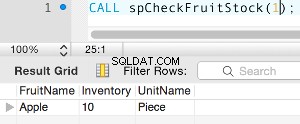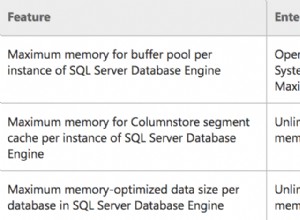Tout d'abord, votre page PHP ou HTML doit produire un formulaire avec lequel l'utilisateur peut interagir. Dans la forme la plus simple, ce serait quelque chose comme :
<html>
<body>
<form method="post" action="yourscript.php">
<input type="text" name="yourfield">
<input type="submit" name="youraction" value="save">
</form>
</body>
</html>
Cela donnera à votre utilisateur un formulaire simple avec un seul champ de saisie et un bouton "enregistrer". Après avoir cliqué sur le bouton "enregistrer", le contenu sera envoyé à votre "votrescript.php" en utilisant POST méthode.
yourscript.php devrait implémenter ce qui suit :
- Acceptez et traitez les entrées de votre formulaire.
- Connectez-vous à votre base de données MySQL.
- Stocker dans la base de données.
Dans la forme la plus simpliste, ce serait :
<!doctype html>
<html>
<head>
<title>Process and store</title>
</head>
<body>
<?php
// Check that user sent some data to begin with.
if (isset($_REQUEST['yourfield'])) {
/* Sanitize input. Trust *nothing* sent by the client.
* When possible use whitelisting, only allow characters that you know
* are needed. If username must contain only alphanumeric characters,
* without puntation, then you should not accept anything else.
* For more details, see: https://stackoverflow.com/a/10094315
*/
$yourfield=preg_replace('/[^a-zA-Z0-9\ ]/','',$_REQUEST['yourfield']);
/* Escape your input: use htmlspecialchars to avoid most obvious XSS attacks.
* Note: Your application may still be vulnerable to XSS if you use $yourfield
* in an attribute without proper quoting.
* For more details, see: https://stackoverflow.com/a/130323
*/
$yourfield=htmlspecialchars($yourfield);
} else {
die('User did not send any data to be saved!');
}
// Define MySQL connection and credentials
$pdo_dsn='mysql:dbname=yourdatabase;host=databasehost.example.com';
$pdo_user='yourdatabaseuser';
$pdo_password='yourdatabaspassword';
try {
// Establish connection to database
$conn = new PDO($pdo_dsn, $pdo_user, $pdo_password);
// Throw exceptions in case of error.
$conn->setAttribute(PDO::ATTR_ERRMODE, PDO::ERRMODE_EXCEPTION);
// Use prepared statements to mitigate SQL injection attacks.
// See https://stackoverflow.com/questions/60174/how-can-i-prevent-sql-injection-in-php for more details
$qry=$conn->prepare('INSERT INTO yourtable (yourcolumn) VALUES (:yourvalue)');
// Execute the prepared statement using user supplied data.
$qry->execute(Array(":yourvalue" => $yourfield));
} catch (PDOException $e) {
echo 'Error: ' . $e->getMessage() . " file: " . $e->getFile() . " line: " . $e->getLine();
exit;
}
?>
<form method="post">
<!-- Please note that the quotes around next <?php ... ?> block are important
to avoid XSS issues with poorly escaped user input. For more details:
https://stackoverflow.com/a/2894530
-->
<input type="text" name="yourfield" value="<?php print $yourfield; ?>">
<input type="submit" name="youraction" value="save">
</form>
</body>
</html>
La clé à retenir ici est d'utiliser des instructions préparées pour éviter les attaques par injections SQL .




